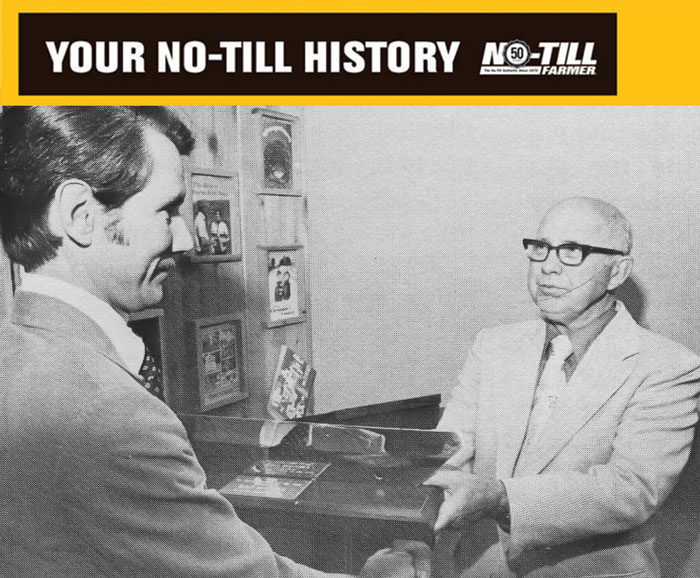Editor’s Note: Walt Buescher was an early believer in no-till and did more than anyone else in the late 1960s and early 1970s to promote the new concept. As a marketing executive at Allis-Chalmers (A-C), he devoted himself to the no-till movement, holding countless meetings with dealers and farmers around the continent. Walt spent his time selling the idea of no-till and was a true pioneer deserving of the No-Till Farmer Retired Plowshare Award in 1977.
His words are among my all-time most meaningful testimonies: “When No-Till Farmer first came off the press in 1972. It was a voice crying in the wilderness. It filled a need for insightful information and data when most of the other farm publications were hoping no-till was just a fad and that the idea would go away.”
Walt passed away in 2009, but he’d be proud to see no-till’s legacy continue and thrive. Below is Walt’s first-person recollection of those early days. – Frank Lessiter, Editor
Having spent 39 years in the farm equipment industry, I was fully aware of the fact that new machines aren’t unanimously accepted everywhere immediately. Thank goodness they aren’t, as the factory couldn’t keep up if a deluge of farm equipment tool orders had come from everywhere at the same time.
Folks Pretended No-Till Wasn’t There
No-till practically became standard equipment in Kentucky from the outset and Virginia followed close behind. The Deep South pretended no-till wasn’t there, as did many other parts of the country. In fact, University of Illinois agronomist George McKibben at the Dixon Springs Agricultural Center in southern Illinois had a running battle going on regarding no-till vs. the university folks at the Champaign/Urbana campus.
Personal Memory of Walt Buescher
“Walt Buescher was a superstar on a team whose future would be moved to a new franchise. We talked to him several times in his retirement in Tennessee. He was at times reflective, sometimes bitter, that all the history of successes and innovations of the Allis-Chalmers’ Farm Equipment Division were ‘sold down the stream’ by the parent company as one of the few assets that’d draw money in a sale. He was ‘all-in’ on marketing the trademarked No-Til, realizing it was the wave of the future. He also knew it would mean, at that time, a decrease in demand of tillage and of high-horsepower tractor sales. That was visionary.
“His enjoyable book, Plow Peddler, is a must-read to understand his role in promoting Allis’ engineering, which would change agriculture worldwide. The book will also change the way one looks at the people behind the scenes of all the equipment you own.”
– Tim Brannon, Allis-Chalmers (A-C) product rep (1975-78) and owner of B&G Equipment, Paris, Tenn., December 2021.
One Prairie Farmer had an article entitled “No-Till Fails Again.” A professor from Illinois said his no-till plot came out 65 bushels poorer than his conventional till. The next time I saw George, I asked, “Why would a PhD admit in the public farm press that he failed worse than every farmer in the state?” George replied, “Doggoned if I know, particularly since I had some no-till fields that beat his conventional plot.”
A running no-till battle also was going on in neighboring Iowa. At a field day at Ames, an elderly set of professors said they had 30 years of data to back up their recommendations for conventional tillage. At the next stop on the field tour, a group of young professors told us, “Those old Iowa State guys have 30 years of obsolete research that they don’t want to throw away before they retire. It’s outdated. Listen to us. No-till and minimum-till is the future.”
No-Till’s Better But ...
At another Purdue University field day, a professor told people on a wagon, “This is our no-till plot. It has fractured the soil structure; it has done everything that shouldn’t be done and yet it has outyielded the previous year’s plot 4 years in a row. No questions, please.”
Afterward, I asked a surprised professor to fill in the blanks. “If I’d seen you on the wagon,” he replied, “I would’ve kept my trap shut.”
Pennsylvania also had a no-till civil war going. Pennsylvania Farmer told of a dismal failure with no-till. From the outset, I figured no-till was a natural for the Soil Conservation Service (now the NRCS), but the government folks paid little attention for 10 years.
At the University of Guelph in Ontario, Jack Tanner and George Jones planted no-till corn on a rocky hillside of Canadian fescue. It was so rocky you couldn’t jab a pitchfork into the dirt without hitting a rock. It never harvested fewer than 100 bushels of corn. I figured their input costs were just $35 per acre in those days on $1 per bushel corn.
Ontario was low on heat units, and there are precious few heat units in the field when there’s still snow in the fence rows. But Tanner no-tilled and did real well, thank you.
The 2024 No-Till History Series is supported by Calmer Corn Heads. For more historical content, including video and multimedia, visit No-TillFarmer.com/HistorySeries.






